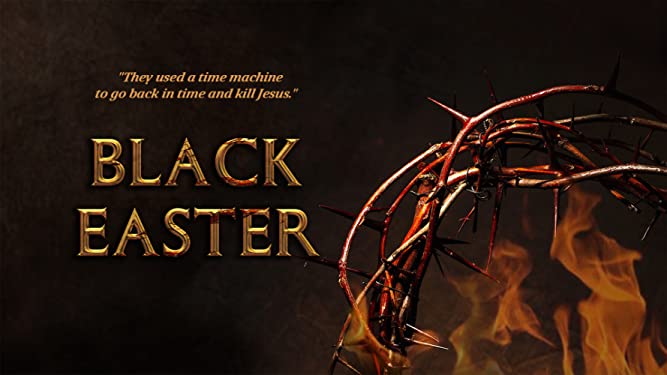The Fascinating Jesus Film You Probably Haven’t Seen
A review of the “faith-based” flop Black Easter and what its failure reveals about conservative Christian media today

(Movie poster for the film Black Easter)
One of the most jarring details in the New Testament is a fleeting mention in Mark’s gospel of a man streaking: “A young man, wearing nothing but a linen garment, was following Jesus. When they seized him, he fled naked, leaving his garment behind” (Mark 14:51-52). Biblical scholars have long puzzled over this line. Some have speculated that this naked man was a disciple who eventually authored the Gospel of Mark. Others believe the sentence is a holdover from an earlier story that accidentally made it into this one. But a 2021 “faith-based” film called Black Easter has a different explanation. The streaker was actually a genius scientist named Ram Goldstein who, after accidentally inventing time travel, goes back in time from the contemporary United States to ancient Judea to save the world by foiling—I kid you not—an Islamic terrorist plot intent on killing Jesus with machine guns before the Romans can do it via crucifixion.
If this movie sounds to you like it shouldn’t exist, you are not alone. But it does. And both its existence and its commercial failure tell us much about conservative Christianity in the U.S. right now. The film aligns with several recent trends in hyper-masculine, nationalist Christianity. And yet, conservative Christian critics have complained that it trifles with the Bible’s account of Jesus. As a biblical scholar who writes on White evangelicalism, I can’t help but think that what actually bothers these critics is that the movie illustrates something more convenient for them to overlook: that conservative White Christianity and its politics are driven less by fidelity to the Bible than by White nationalist longing for Christian supremacy.
I also can’t help but be entertained by the whole saga. Black Easter is a lightly edited version of the 2020 film Assassin 33 A.D. but with an overwrought voiceover explaining the bits that might have seemed complicated in the first movie. The original version is the better film, but Black Easter is more easily accessible via mainstream streaming services. Both are written and directed by Jim Carroll, a Texas-based businessman, professional gambler, and dabbler in Christian media. “Writing this story,” he commented in one interview, “is just kind of my way of trying to express my heart toward God, in a fun way.” Carroll’s website markets him as an entrepreneur extraordinaire with tales of overcoming all manner of adversity and lists a range of previous ventures, including a reality television show called “Marriage Boot Camp,” a job as a bounty hunter, and award-winning forays into disco dancing. The site also proclaims that thrice-married Carroll “had many battles with crooked preachers” before joining a non-denominational church in Frisco, Texas.
Despite Carroll’s perceived marginalization of himself and his efforts, Christian ascendancy looms large as a theme in Black Easter. The film advances classic tropes of post-2001-era Christian nationalist Islamophobia, even as the dialogue works overtime to distinguish its villain as an “extremist.” Our mastermind bad guy is Ahmed, a Middle Eastern billionaire, played by Mexican American actor Gerardo Davila, who is now in the U.S. and financing top secret science experiments in his heavily surveilled lab. His parents, we learn in a flashback, were Christians murdered by Islamist extremists. Years later, defying logic, Ahmed seethes at Christianity. When a team of plucky young geniuses that he hired, led by Ram, makes time travel possible, Ahmed decides to eliminate Christianity from world history by shooting Jesus in a bid to thwart his earliest followers.

(A scene from Black Easter)
Here the film betrays a gross misunderstanding of Islamic teaching, which holds that the great prophet Jesus did not in fact die at all—by crucifixion or any other means—and was instead assumed into heaven. The film displays no real knowledge of Islam or Muslim ideas about Jesus. At one point, Ahmed says to Jesus, “I really would’ve liked to have killed you myself.” The film’s villains and their “evil plan” only make sense as a totalizing Christian fantasy in which Jesus, and by extension modern Christians, need defending against a world out to get them. For informed viewers, it will ring false. But Ahmed’s best line, delivered with near-comic gravity, could not be further from the truth: “A time machine…changes…everything.”
It is difficult to capture without spoiling too much just how funny this movie is, both when it means to be and when it’s so bad it’s good. In some scenes, I had a hard time telling the difference. To take one example: atheist Ram comforts a dying fellow scientist named Simon by speculating through sobs that heaven is “probably a frat house with lots of beer.” Though played for comedic relief, this line will not amuse viewers concerned about or harmed by hyper-masculine Christianity. The real gag here is that such a line made it onto the screen at all. The film never shows us what heaven is like. But we do get to see a short scene of the apocalyptic wasteland the world could have been if Christianity were erased from history. The world needs the resurrection.
Amidst all the absurdity, Black Easter also tackles serious issues as the movie explores themes of forgiveness and the human condition, advances reflections on theodicy, and simultaneously takes significant risks in how it plays with the New Testament’s stories about Jesus. Black Easter is a fascinating cultural product because of those risks.
Jesus on film is a touchy subject for Christians. Think of Christian protests of the depictions of Jesus in Monty Python’s Life of Brian (1979) or Scorcese’s The Last Temptation of Christ (1988). How do you depict a first-century Jewish man as both fully human and divine? How do you entertain without crossing a line of reverence or respect? Black Easter throws caution to the wind: Jesus, played by former American Idol contestant Jason Castro, is both savior of the world and mouthpiece for Terminator lines: “I’ll be back.”

(A scene from the 1979 film Monty Python’s Life of Brian)
And indeed he does come back—despite all the odds this movie throws his way. Despite the enemy extremists’ efforts to prove he wasn’t God and wipe Christianity from existence. Despite the heroic Ram’s science-informed, atheist doubts about the very possibility of defeating death. Despite the efforts of sidekick scientist Simon to talk Jesus out of voluntarily submitting to a painful death. The film takes Jesus’s identity as God seriously.
The Bible, one might conclude, is treated with less gravity. While Black Easter overwhelms viewers with sub-plots of romance, revenge, childhood trauma, and male hubris, we find at its core a fantastical revision of how the Bible came to be, as we learn the “true” story behind what the New Testament gospels recount.
Let’s cut to the film’s resurrection scene to see how this works. Having failed to prevent the crucifixion (in the principal timeline), Ahmed materializes in the year 33 and now stands inside Jesus’s sealed cave-like tomb. Illuminated only by the green gleam of his military-grade chemical light sticks, he talks to Jesus’s dead body (“dead as dead can be”), wrapped in linens and lying behind him. “There will be nobody to remember you,” he threatens.
His plan to outpace the Romans in killing Jesus now foiled, Ahmed must improvise. He puts aside his trusty gun and suddenly plunges a syringe into Jesus’s body to take a sample for his lab, which he wants to use to prove to the world that Jesus was not divine. Before the viewer can finish wondering how Ahmed will get a DNA sample from God to debunk Jesus’s divine paternity, the ground starts shaking. The linens on Jesus’s body shine brightly. The stone in front of the tomb bursts into pieces (no rolling away in this telling like you’d find in Mark 16:4, Matt 28:2, Luke 24:2, and John 20:1), and the Roman soldiers standing guard are knocked down by the force.
At the same time, Ahmed uses a time retriever bracelet to go back to the future. As he disappears, the scene shifts to just outside the tomb to Ram, Simon, and their colleague Amy, who has played the stalwart believer throughout the film. “He is risen!” she exclaims, with obvious relief and characteristic vocal fry. Ram, still doubting, objects. Amy enjoins them to “go check it out.”
When Ram and Simon enter the tomb, there is no body. Only neatly folded white linens—and glow sticks. Ancient women, presumably those from the gospels who discover the empty tomb, enter and are startled to see these American youths—and glow sticks. Not knowing what else to do, Ram holds up the green lights and flatly rehearses a line he knows he is supposed to say in this moment but feels awkward about delivering: “He…is…risen…?”
So that’s who Mary Magdalene and the other women saw in the tomb! It was not, after all, angels (John 20:12) whose “appearance was like lightning” (Matt 28:2-3) or “two men in dazzling clothes” (Luke 23:55) as portrayed in the gospels. It was 21st-century time travelers—with glow sticks!
This conceit plays out repeatedly, as modern Americans come to populate the ancient gospel stories narrating Jesus’s last days. We watch our scientist Simon become Simon of Cyrene, the man who carries Jesus’s cross in the New Testament (Mark 15:21 and parallels). A repentant henchman named Brandt, who has had a faith journey all his own, winds up on the cross beside Jesus and asks him for forgiveness, just like “the good thief” in the Gospel of Luke. Amy, like Mary Magdalene in the Gospel of John, is the first to encounter the risen Jesus in the garden outside his empty tomb.
While a didactic description makes this plot device sound heavy-handed or even cheesy, the pacing of these moments turns their unfolding over the course of the film into opportunities for pleasure on the part of certain populations of viewers: those who are familiar enough with Bible stories to feel satisfaction as they puzzle out which time travelers become which biblical characters. The film invites viewers with this skill set into its own cleverness, rewarding an in-group who know their New Testament gospel stories well.
So, who exactly makes up Black Easter’s audience? Carroll’s film, in both iterations, has struggled for distribution. In a public social media post dated May 22, 2017, Carroll wrote that “Cinemark slammed the door” on the film, complaining that the movie theater chain “can’t think outside the box.” He reports that he aspired for the movie to be a sci-fi flick on par with blockbusters like The Exorcist and Raiders of the Lost Ark, but with Christian themes embedded. “I want to make something that everybody wants to go see,” he said, “and then, hey, I can stick my message in there and it doesn’t really offend anybody.” But Black Easter cannot appeal to a wide mainstream audience because of its transparent Christian supremacy and not-very-subtle apologetics for the existence and dominance of the Christian God.
Yet, as a recent movie parody of Christian filmmaking—appropriately titled Faith Based—deftly illustrates, there is money to be made and success to be had with movies aimed at conservative Christians that make them feel good about their beliefs and their perceived difference from “secular” culture. Bad movies can make for big business when marketed to evangelical Christians.
But Black Easter and Assassin 33 A.D. haven’t triumphed in that realm either. Neither has enjoyed the kinds of wild success that some independent faith-based movies have in recent years among Christian audiences. Take, for example, the massive God’s Not Dead franchise, now in its fourth installation. The original film in that series (2014) had a $2 million budget, pulled in over $9 million on opening weekend, and grossed nearly $65 million worldwide.
Details of how Black Easter was funded are scarce. A 2016 crowd-funding campaign on Carroll’s part to raise money from Christians to produce his movie ended unsuccessfully. With a total of just 11 backers, the campaign raised only $1,600 towards its $20,000 campaign goal, a fraction of the total advertised budget of $1 million. Two years later, a Facebook post on Carroll’s page solicited donations to help get his film in front of viewers as an evangelization effort. “The Christian distributors are scared to death of a movie that is outside the box,” the post reads.
In reality, Carroll’s film is too Jesus-y to be mainstream but also too heterodox for Christians who see the Bible as holy history. Christian film reviewers have criticized it harshly. A reviewer for an organization called the Dove Foundation, whose self-styled mission is to “encourage and promote the creation, production, distribution and consumption of wholesome family entertainment,” concluded that Assassin 33 A.D. is “Not Dove-approved.” Taking issue with what he sees as “theological confusion and biblical contradictories,” the reviewer writes that the movie “takes free reign [sic] to reinvent the Gospel story, but many of their reinventions contradict the power of Jesus and the authority of the Bible.” (The review also warns viewers about “nudity”— Ram becomes the Gospel of Mark’s partially naked man running away after he frantically disrobes to use his garments as makeshift tourniquets for Amy’s wounds.) Another reviewer has suggested that “The people who made Assassin 33 A.D. need to spend less time thumping their Bible and more time actually studying it.”
I wonder, though, if it is actually the Christians who reject Carroll’s movie as insufficiently Christian who are doing the Bible-thumping. They are, after all, judging Black Easter and Assassin 33 A.D. by a conservative standard that defines Christian orthodoxy by a particular brand of Bible-fidelity. Jesus-followers have not always seen the gospel stories as out of bounds for imaginative play or fictive speculation. Think of the ancient non-canonical Gospel of Peter, which fills out Jesus’s resurrection scene and famously depicts a walking, talking cross. Likewise, the Infancy Gospel of Thomas creatively supplies details of Jesus’s childhood that are missing from the Bible, including a scene in which the precocious savior-in-the-making becomes angry, kills a playmate, and then must bring him back to life. In the modern era, film classics like Ben-Hur (1959) and The Robe (1953) were welcomed by Christian audiences for their explorations of gospel-related characters.
Black Easter, by contrast, has not found a friendly reception among Christian critics because it rewrites, rather than supplements or expands, the Bible. Carroll takes liberties with the story of Jesus that reorient rather than organically expand the narrative. Ironically this move makes the film resemble the New Testament gospels themselves, which tell different stories of Jesus’s life that reflected the idiosyncrasies of their authors. The author of the Gospel of Luke, for example, tells us that he knew about other gospels, used them in his research, but ultimately arranged all the details of Jesus’s life in his own way, to make a pleasing story for his readers (Luke 1:1-3).
Perhaps we have not seen the end of Carroll’s Bible-themed filmmaking. Black Easter’s conclusion sets up a potential sequel, this time drawing on the book of Revelation and evangelical end times theology. Remember the DNA sample that Ahmed took from the tomb? In the final scenes, we discover that he has used it to clone Jesus, accidentally creating the Anti-Christ and, apparently, ushering in the end of this age. Carroll’s experience in bounty hunting, gambling, and identifying “crooked preachers” would probably come in handy here. Until then, we will have to find ourselves content with this daring Jesus film that failed on almost every front except imagination.
Jill Hicks-Keeton is Associate Professor of Religious Studies at the University of Oklahoma. She is the author of Arguing with Aseneth: Gentile Access to Israel’s Living God in Jewish Antiquity (Oxford University Press, 2018) and coauthor with Cavan Concannon of Does Scripture Speak for Itself? The Museum of the Bible and the Politics of Interpretation (Cambridge University Press, forthcoming). She is currently at work on a book entitled Good Book: How White Evangelicals Save the Bible to Save Themselves. Find her on Twitter @JillHicksKeeton.